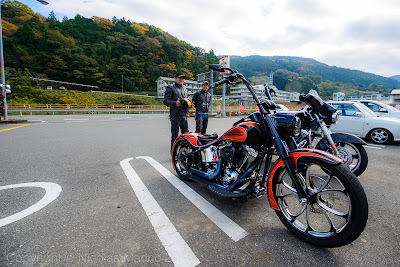Despite the virtually infinite urban continuum along Japanese routes, there are some places where there is relatively a higher proportion of nature. Needless to say it is never an unspoiled nature - one simply doesn't come to Japan in search of adventure because there isn't any - but it is nature in the end and, on the island of Shikoku in autumn, it is especially beautiful. After taking nearly a dozen boats and ferries during this last year, some passing through traditionally stormy waters, it was almost surprising that there had never been strong tides. More surprising still, would be that when crossing to Misaki, in the peninsula's turquoise waters of Sadamisaki, we arrived yellow in color and almost puking. What a tide out of Saganoseki! In just 10 minutes it forced me to lie on the floor and it made of the remaining 60 the closest thing to being inside an operating washing machine. It was not until the next day that the remaining headache was definitely gone. My surname is Marino (it means “sailor” in Spanish) but it seems that such surname didn’t endowed me with any extra maritime skills.
Shikoku is a mountainous island famous for its 88 temples and the pilgrims who make the walking journey to each of them. They go along 1400 km on foot, with minimal possessions, soberly dressed in white, cone-shaped hat and armed with a walking stick for the arduous climbs and descents. It takes about 60 days to complete and you can see them along all the way. The villages are small and in them, it is possible to reconnect with more traditional Japanese images after so much hectic futurism.
New castles of smaller proportions appear in the villages, which bring back the images one might have of Japan after reading the stories of emperors, shoguns and samurais.
Going into the Ehime Prefecture, the road becomes very beautiful, entering and leaving small canyons of dense vegetation and colorful trees,crystal clear emerald green rivers along an ever winding road.
Mountain passes in Japan - after all of the ones that I've accumulated in my life - are truly a joke. With slopes of 5 or 6% on paved roads smooth as silk, the easiest of the Tibetan descents is extremely difficult compared to a Japanese climb. I can ride with one hand and change music in the mp3 with the other without increasing my heart rate. To make it even easier, you never reach a real mountain pass, there are tunnels everywhere and to make it easier on easier, there are exclusive tunnels for bicycles such as those in Korea. The lighting makes me feel that I am cycling along the corridors of the Death Star, and in the echo of its walls as I cycle along, I can feel Darth Vader breathing on my neck while I do not carry Obi Wan Kenobi's light saber to defend my Princess Leia. Even in the countryside, Japan does not let you forget that it is the most technologically advanced country in the world.
To the tunnels are added bridges that take us from one riverside to the other, to avoid slopes and do everything very simple. The day are radiant though a bit cold but they are relaxing days, we're not in Japan in search of adrenaline or at least, one must convinced himself of this in order to prevent falling into boredom.
On Japanese routes we never stopped watching the comings and goings of the fans of motorcycles. A strange feeling because most of the bikes that would pass us were Harley Davidson's instead of Kawasaki Ninjas.The famous U.S.A touring motorcycle is not only a motorcycle of worship in that country but it seems that such cult is here as well. I find it curious that, after having received two U.S atomic gifts, the Japanese have decided to import so many cults from there, because this is not the only one, there are many others. Local motorcyclists invest fortunes "tuning” their Harleys to the extreme and fully dress up in leather like rock-and-rollers to go out and show off their machines, making it in the image and likeness of their US peers although their Asian bodies have not endowed them with neither a long ZZ Top beard nor a giant beer belly.
Motorcycles have never struck me particularly, but some of these are very impressive and I must confess that I really wanted to try how it feels to ride one.
After passing Kochi on our way to Tokushima, we cut through the islands heart along the magnificent canyons of Oboke and Koboke, where the route becomes a narrow corridor between walls of colors and a twisting emerald river roaring below.
The large number of tourist buses somehow ruins the beauty, but we are in Japan and even this, is more quiet and orderly than in any other tourist place in the world. The second canyon is not as shocking as the first but serves as a beautiful continuation of the road.
They were quiet days of easy travel although with enough visual beauty. Arriving at Tokushima, we would take the last ferry to cross to Honshu, the largest banana-shaped island that is seen in a map of Japan. Nature would become an anecdote between populations, traffic and industries. It was time to embark on the final path to Tokyo but not without first passing through Osaka and Kyoto.













Superb reading, and excellent photos - you chose the right time of year for the gorgeous autumn foliage! It's a bit dull in Japan right now...
ReplyDelete